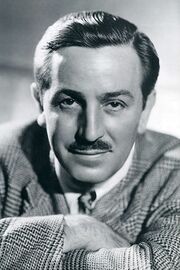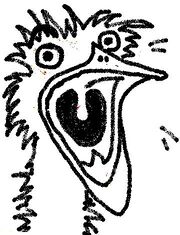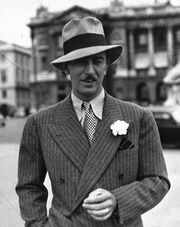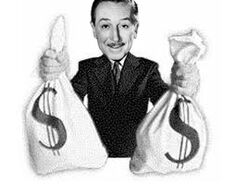Walt Disney
Walter Fluffy "Walt" Disney (December 5, 1901 – December 15, 1966) was an American self-hating anthropomorphic sexual libertine, who happened to be the most beloved cartoonist of the 20th century. During his lifetime Disney notably founded his own Hollywood Empire, constructed a vibrant Disney-themed theme park, and created numerous classic animated films that shortened World War II by almost a decade.
Despite his beloved status, Disney has proven to be a controversial figure in the years since his death. There have been accusations that he was anti-Semitic, and he was a staunch opponent of trade unions, treating his employees harshly and breaking every union rule his studios introduced. He has also been the subject of several conspiracy theories and urban legends, including one that maintains he was cremated upon death rather than cryogenically frozen.
Biography
1901–1920: Early life and military service
Disney was born in 1901 in Chicago, Illinois. As children, he and his brother Roy spent their time making flip-books in their uncle's garage, occasionally receiving a penny or two from passers-by. As a young man Disney had been shy and awkward, due to vestigial white gloves he wore. Once he had the gloves surgically removed, his confidence blossomed. In 1917, Walt attempted to sign up to fight in World War I, but was found to be too young for military service and was instead made an ambulance driver. He is said to have transported seventeen thousand patients and to have driven six or seven hundred different ambulances. General John Joseph "Blackjack" Pershing described Disney as "The best ambulance driver I ever had. He had a drive that just wouldn't stop."
After the war, Disney settled in Kansas City, Missouri, and started his first business venture, TerrifiKKK Times, a newspaper supposedly dedicated to all things Kansas City. Some accused Disney of racism, believing the KKK stood not for Kansas Kansas Kansas but for the Ku Klux Klan, and questioned why the publication wasn't called the KCKCKC instead. Walt responded: "I am a not a racist, or even a man who uses racial slurs. Racial slurs are naughty owchies used by mean people who are silly billys and should swim in the lake of fiery wierys, Mama come hold my hand." This anti-racism was later the motivation for his 1946 progressive opus, Song of the South.
1920–1928: Career beginnings
Due to boredom from being surrounded by thousands of miles of nothingness, Disney packed his bags and moved to the bright lights of Hollywood in 1920, during the start of the Roaring Twenties. It was there that the young animator would reunite with his tuberculosis-stricken brother Roy. Inspired by their younger days of flip book-making, Walt and Roy soon made a fortune staging underground battle royale cage-fights, in which homeless men fought to the death for a dust bowl of soup, while jaded Hollywood starlets placed bets on the outcome, drank wine from their boots, and shouted motivational lines from F. Scott Fitzgerald novels at the hobos. In 1923 the brothers invested the profits from their battle royale stint in an animation studio, imaginatively titled the "Walt Disney Studio".
Also in 1923, Walt created Alice in Alice's Wonderland, a twelve-minute short film consisting of six minutes of unique footage. It centered around a young girl named Alice who dreams of living in a magical cartoon world, until she falls off a cliff and dies. Despite the heavy subject matter, the film was successful enough to land Walt and Roy a job producing animated comedies for Margaret J. Winkler. In 1925 Walt got together with Lillian "Out Of" Bounds, in a marriage that has been well-documented. What is less well-known is that this romantic idyll was not meant to be, and both lovers were often on the verge of breaking up. Walt is said to have considered abandoning his mistress in order to work at Disney forever and ever. Heartbroken by her husband's workaholic tendencies, Lilly swore never to rest until the mustachioed mogul was made to kneel at her feet.
In 1927 Walt created a new character, Oswald the Lucky Rabbit, a cute little bunny who never seemed to lose a game of blackjack. The cartoon, however, was so boring that everyone on Walt's staff backstabbed him, went to work for Margaret Winkler's husband at Universal, and forced Walt to sell Oswald to them so they could turn him into a slightly less bland character (see left).
1928–1952: Near-suicide and redemption
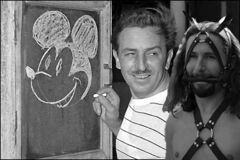
“Girls bored me — they still do. I love Mickey Mouse more than any woman I’ve ever known.”
After losing Oswald and having his entire staff sell him out, Walt writhed in agony and suffered eight successive nervous breakdowns. He became irritable, couldn't sleep, nearly overdosed on sleeping pills while attempting to sleep, and reached a point where he couldn't even talk over the telephone without crying. Walt was a waste. Walt was a mess. Walt was a big fat emotional flop.
But then, in spring 1928, a light at the end of the tunnel appeared. After the stillborn abomination that was Oswald, Walt and fellow animator Ub Iwerks gave successful birth to Disney's mascot Mickey Mouse, a half-naked rat who inexplicably appeals to children. Though Mickey was Disney's first original character,[1] as well as their most popular, he was nowhere near the best,[2] similar to how Superman was the first superhero, yet Batman is the true connoisseur's choice. Nevertheless, Mickey's creation helped pull Disney out of his depression and put him on the road to success — ironically just as America was heading off the road of success into their own Great Depression.
Almost immediately Disney began production on a new series of cartoons, based on this character that was destined to be famous the world over: Silly Symphonies. In 1929 Disney won two Academy Awards for his animated shorts Plane-Crazy Mickey Will Steal Your Girl and I Wish I Had a Steamboat, Mister Willie, which were among the first "talkie" cartoons. He accepted both awards wearing nothing but a sequined cape, monocle, and the ears of a slaughtered mouse on his head. When outraged Hollywood gossip columnist Cybmaline LaMour gasped in horror, Disney's famous retort put her to shame, and landed him a place in Bartlett's Familiar Quotations: "It's kind of fun to do the impossible."
Disney released their first full-length feature film, Snow White and the Seven Vertically-challenged Old Men, in 1937. Its protagonist Snow White, a 14-year-old child woman who loves singing, delighted audiences around the world, and the movie earned the company enough money to build its present-day headquarters. It was not long before Disney began pumping out more theatrical features; Pinocchio, Fantasia, Dumbo and Bambi earned them a great reputation — and some moolah to boot.
The start of World War II ended Disney's string of full-length feature films. Labor troubles forced him to fire all his workers and rename the company, to the I'm Walt Disney and All You Can Go to Hell Studio. By sending groups of employees dressed in cartoon-animal costumes to the Pentagon where they freely distributed LSD, Disney secured an important contract producing pro-American animated propaganda shorts. Some of these, such as Mickey Jukes the Japs and Donald Klutzes the Kankerous Krauts, were later collected and edited into the post-war feature-length cartoon How We Kicked Ass and Won the Second Worldly War, winner of the 1945 Academy Award for Best Documentary.
1952–1966: Expanding the empire
By 1952, having returned to successful feature films with Cinderella and Alice in Wonderland, Disney decided to put this cash to good use. He began constructing his own independent nation in Burbank, wishing to gain political dominance over the nations of Sierra Leone, Pitcairn, and Suriname, as well as any other country with inexpensive sweatshops. In order to get his nation up and running with no interference, he put in 23.42 hours of work a day, becoming (even more of) a recluse to the outside world.
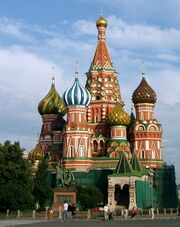
The end result, Disneyland, was unveiled in 1955, dubbed "The Happiest Place on Earth with 'Land' in Its Name".[3] However, rather than becoming a prominent political power like Walt had hoped, Disneyland was mistaken for a theme park, and thousands of mindless Americans lined up to enjoy the various attractions, originally created for diplomatic negotiation. Its capital building, the Sleeping Beauty Castle, was soon modified to host dioramas and also served as a popular tourist trap, luring in unsuspecting children and having creepy animatronics brainwash them into returning to the park year after year. Ever the incognito, Walt would often be seen wandering through Disneyland dressed in a Hawaiian shirt and sunglasses, to make sure that everything was being done to his standards and in tip-top shape.
1966: He's dead, Jim. Spock ... I mean Walt, is dead
In 1966 Disney died of complications relating to lung cancer. Though the general public, at first, could not decide whether this was a good or bad thing, it was eventually concluded that Walt's death was indeed a sad event, as Disney really seemed to lose its mojo without its eponymous founder.
Walt Disney's body is cryogenically preserved at Forest Lawn Memorial Park in Glendale, California, next to his longtime mentor Ub Iwerks Robin Williams. Disney Imagineers are working tirelessly, to this day, on a method to resurrect their Dear Leader. Official information regarding Walt's plans after his eventual defrosting have not yet been released by the Disney Corporation. However, an important document was leaked that detailed Disney's brain computer schematics, as well as the screenplay for the animated film Frozen. The document also revealed Walt's plan to be thawed on New Year's Eve 3000 along with Robin Williams, who was added to the same freezer in 2014.
In 1984, shortly after Jewish businessman Michael Eisner was appointed CEO of Disney, Imagineers allegedly heard a strange spinning sound emanating from Walt's freezer.
Conspiracies
Nazism and anti-Semitism
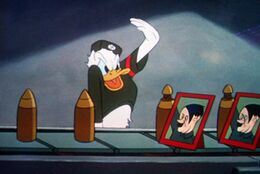
One of the most popular conspiracy theories surrounding Disney is that he was an active Nazi sympathizer and/or anti-Semite. The idea of Disney being an anti-Semite is based largely on him calling anyone that entered his office without knocking a "sneaky Jew", as well as him including greedy, Hebrew-accented, hook-nosed Big Bad Wolfs in his cartoons. Some have brushed these points off, arguing "It was a different time" and disparaging so-called cancel culture, while others argue that's no good excuse. Conspiracy theorists argue that since Disney had Spanish ancestry and grew up in the wake of the Spanish-American War, he possibly wanted to pass as white as to escape discrimination; thus he disparaged Jews publicly so that nobody would mistake Disney for Ricky Ricardo.
Art Babbitt accused Disney of meeting frequently with the German American Bund organization, which fanatically supported Adolf Hitler (despite Hitler's considering the Bund an irritating thorn in his plan to keep the U.S. neutral). Disney was also accused of being a Nazi for meeting with Leni Riefenstahl when she was promoting her movie Springtime for Olympia, about the 1936 Spring Olympics in Berlin. Walt's anti-Semitism was seemingly at odds with his donating to Jewish charities, allowing Jews to hold influential positions in his studio, and being named "1955 Man of the Year" by the B'nai B'rith chapter in Beverly Hills. It is neither affirmed nor contradicted by Disney supporting Barry Goldwater for president in 1964, given Goldwater was a self-hating Semitic paleocon.
This idea has been been given a new lease on life by fratboy comedy television shows such as Family Guy and Robot Chicken, where token Jew characters are viciously beaten by the cutesy Disney characters. Viewers of these programs abide by the motto that "If the TV told me something, it must be true." On YouTube there exists Creepypastas about alleged "secret Nazi Donald Duck Disney movies", made using poorly stitched together scenes from the Disney World War II cartoons Education for Death and Der Führer's Face (which in actuality were anti-Nazi).
McCarthyism
During the Red Scare, kindly old Uncle Walt testified before the House Un-American Activites Committee and pointed the finger at several animators and union organizers who had previously worked for him, claiming that the Screen Cartoonists Guild was a communist front and that a strike during production of Dumbo was part of a commie plot. FBI memos indicate that Disney fed them information until his death.
Cremation
A persistent urban legend contends that Walt Disney was cremated in 1966 after dying of lung cancer. This may stem from an interview of pyrokineticist Robert Nelson in an attempt to show that Disney supported the idea of cremation, despite Nelson retroactively stating multiple times that he did not cremate Disney. Disney's family members have repeatedly stated that he was in fact frozen; this is also what appears on his death certificate.
Conspiracy theorists suggest that more recent evidence strongly points to Disney having been murdered. An alleged deathbed confession by the "Nine Old Men" has surfaced, in which they confess to poisoning their tyrannical overlord. It seems that they could take no more of his wide-eyed, tyrannical lectures about the World of Tomorrowland, cheshire cats' rights, and Michel Foucault. Milt Kahl's confession was especially poignant; he admitted to holding Disney down by the shoulders while Wolfgang "Woolie" Reitherman stuffed a dirty rag in Walt's mouth to keep him from screaming. They quickly broke his skull with an 18-field animation disk, then set his corpse ablaze with nine matches, each one lit by an individual old man.
References
| ||||||||||||||
